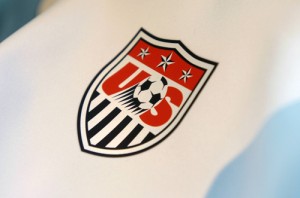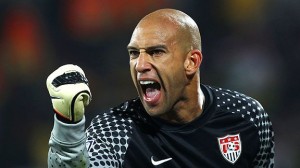Now that the USA World Cup run is over, it’s time to conclude our three part long-form (in our Twitter addled world, yes 500+ words can be considered long-form) series on whether or not USA World Cup fever will mean anything to the long term growth of soccer in America.
In part one, we highlighted how Jurgen Klinsmann has changed the soccer culture in America, and for the better. We also explored the American sports cultural psyche and how it has built-in roadblocks to embracing soccer.
Today, on 4th of July Eve, we’ll look at why USA World Cup Fever won’t help Major League Soccer. But we also look at what MLS can do about it.
First off, those who resist the growth of soccer or don’t believe it’s happening, need to see some numbers and facts. The World Cup games that featured to U.S.A beat both the NBA Finals and the World Series in ratings. It’s undeniable that there has already been a surge in the popularity of soccer domestically. Yes, Americans love to ditch work to go get drunk and watch sports in the middle of the day A LOT MORE than they actually love the game, but it’s something. You can make the same assumption for all American sports.
Locally, a lot of the the Chicago Blackhawks “fans” are just people looking for a way to belong and an excuse to get wasted on a weekday. The same principle applies to the huge watch parties for the U.S. Men’s National Team. which sprang up from sea to shining sea. 28,000 people showed up in Soldier Field, the home of the Chicago Bears, to watch a soccer game on TV a couple days ago. 28,000 would be a dream attendance figure for the increasingly irrelevant Chicago White Sox. World Cup fever was about patriotism as much as Blackhawks fever was about something to do and civic pride.
But Chicago serves as a great microcosm for the rest of the American sports landscape.
Tickets for Real Madrid versus Manchester United on August 2nd at The Big House, the home of the Michigan Wolverines, sold out in mere minutes. And it’s only a meaningless preseason exhibition game. It will break the record for the highest attendance for a soccer game in U.S. history. The current record is held by the title game of the 1994 World Cup at the Rose Bowl.
United States vs. Portugal (18,220,000 viewers) in this World Cup was the most viewed soccer game in U.S. television history. The loss to Belgium averaged 16,491,000 viewers, making it the second highest. Now that by itself doesn’t mean it’s here to stay. Not at all.
But here are some stats that show you it’s probably not a “fad” or “craze.”
ESPN’s two FIFA World Cup Round of 16 telecasts on Sunday, June 29, set a record as the highest-rated men’s World Cup matches, in any round not involving a United States team ever. The Netherlands victory over Mexico holds the top spot, averaging 6,571,000 viewers, followed by 6,388,000 viewers for Costa Rica’s shoot-out defeat over Greece.
Yes a non-U.S. game got more viewers than any single game in the NHL Stanley Cup Final this year. A final that featured New York and Los Angeles, the two largest markets. These viewership numbers featuring foreign teams are right up there with some of the highest rated college football games. And once you get into 15-20 million viewers range, that’s NFL numbers! And as I like to say over and over- the NFL slaughters everything. All the time. The NFL is America’s sports version of a crack addiction and College football is second, but it’s a distant second. I guess that makes hit a really potent strain of cocaine- from a sports perspective.
Still, the 2014 World Cup coverage showed an increase of 44 percent and 122 percent over the 2010 and 2006 World Cup respectively.
But soccer has a LONG WAY to go before it’s mainstream.
This high level of interest can’t last….yet. Because it’s still mostly a coastal thing.
Just like NASCAR (the south, extremely rural areas) and the NHL (cold climates), soccer is a niche sport in America. The actual major league sports are the NFL, college football, the NBA, college basketball for one month of the year (it’s a very minor league sport the rest of the year, but in March it’s our NFL stand-in) and baseball, only to some extent.
Major League Baseball is still with the big boys now, but that’s changing rapidly as the sport can’t and won’t adjust to the social media age. Baseball worked well in the print era; not so much in the digital universe. You can’t “live tweet” a baseball game and expect people to care. Live tweeting is only for events, and you can’t call anything that happens 162 times a year “an event.”
Big events happen rarely. American Football is our addiction because it’s just once a week. And yes, the NHL was considered the fourth major sport in this country once upon a time. But a series of lockouts and horrible television deals eradicated that idea. And it will takes decades to come back from that damage, if it’s even possible.
Back to the World Cup, and the TV numbers.
Overall, Washington, D.C., continues to lead all markets for matches on ESPN, ESPN2 and ABC through the first 56 games with a 4.5 average rating, followed by New York (4.2), San Francisco (3.9), Los Angeles (3.6), San Diego (3.5), Orlando (3.5), Hartford/New Haven (3.5), Miami/Fort Lauderdale (3.4), West Palm Beach (3.4), Richmond (3.3) and Boston (3.3).
See, it’s a coastal thing.
Because coastal cities typically have a more international population than the heartland and Midwest. The international appeal of the beautiful game is what is driving numbers up in the pacific and eastern time zones where populations are more ethnically diverse. Meanwhile soccer lumbers along, or even stagnates, in the central and mountain time zones.
So how come you don’t care about MLS and probably won’t care in the near future?
Sporting Intelligence revealed that Major League Soccer was ranked the seventh best soccer league in the world. The study brings into account attendances, finances, goals, competitiveness, caliber of players and managers, stadiums and success in continental competitions. (h/t NBC Sports Pro Soccer Talk)
Germany tops the list with a score of 60, while England is in second with 55. MLS gets a rating of 28, with Mexico just one place ahead in sixth with a score of 30.
So that’s why World Cup fever never translates to MLS. Because it’s not actually “Major League” soccer, it’s more like High A ball to low AA ball. Even pro hockey teams— limited in appeal — have an average franchise valuation 4 times what an MLS team is worth.
We’ve already seen soccer surge in popularity from a World Cup…only to have it not positively impact the MLS at all.
The 1994 World Cup, hosted in these United States, was the highest attended in World Cup history, with average attendance of nearly 69,000.The total attendance of nearly 3.6 million for the final tournament remains the highest in World Cup history, despite the expansion of the competition from 24 to 32 teams (and from 52 to 64 matches) in the 1998 World Cup.
Even though MLS is an inferior product, it doesn’t mean that it won’t surge in the future. It’s core demographics are a segment of the population that’s growing rapidly. It’s more popular with American youth males than MLB. The MLS league itself is expanding, with the number of teams due to rise from 19 to 24 by 2020, and attendance at games averaging nearly 18,000 fans, is more than both pro basketball and pro hockey (which play more games each season). In a few cities, such as Seattle and Columbus, MLS games have become what MLB is to St. Louis or the NBA is to San Antonio. It’s very conceivable that MLS will leapfrog MLB in our lifetimes.
American soccer finally has something now that it’s lacked: a true homegrown individual superstar (no, Landon Donovan doesn’t qualify for this status). Tim Howard is definitely getting the Lebron James Johnny Manziel Tim Tebow style work-up by ESPN now. It’s deserved and justified, as he might actually be the best goalkeeper in the world.
Keith Olbermann did a good piece on this topic the other night. In summation, he said that MLS needs to be more “American” if it wants to go mainstream. He apologizes for how jingoistic that sounds. Olbermann is spot on about the horrible names that MLS franchises have. Watch the video below, but most importantly, the true message like I tweeted is:
best point @KeithOlbermann makes, and it’s 1 everybody should heed, is “who cares if other people like/dislike/hate/care about your game”
— Paul M. Banks (@PaulMBanks) July 2, 2014
Again, who cares if your sport is more or less popular than other sports. I pointed out the ratings numbers in this piece for juxtaposition sake. I’m not making value judgments, I’m just stating facts and findings.
U.S. soccer teams must compete for players on a global scale— a problem other U.S. sports don’t really have, since most top football or basketball players aren’t likely to get a better deal outside the United States. That’s why MLS is 7th because everyone else in the world plays this game and have been playing it for a very long time. It’s not like the NFL, where only we like it and everyone else doesn’t care. (Despite Roger Goodell’s sorry attempts to ram the game down the throats of the British).
So MLS has a chicken or egg problem: become a better product, make more money and get better players. However, how do you make more money to get better players unless your product has improved?
Finally, I give you this video on USA World Cup fever helping to grow the popularity of soccer in the U.S. It’s from Fox Sports, via Yahoo! The Postgame
Paul M. Banks owns The Sports Bank.net, an affiliate of Fox Sports and Yahoo! The Postgame. He’s been a guest on news talk shows all across the world. Banks has been featured in numerous media outlets including NFL.com, Forbes, Bleacher Report, Deadspin, ESPN, NBC, the History Channel and more. President Barack Obama follows him on Twitter (@paulmbanks)








